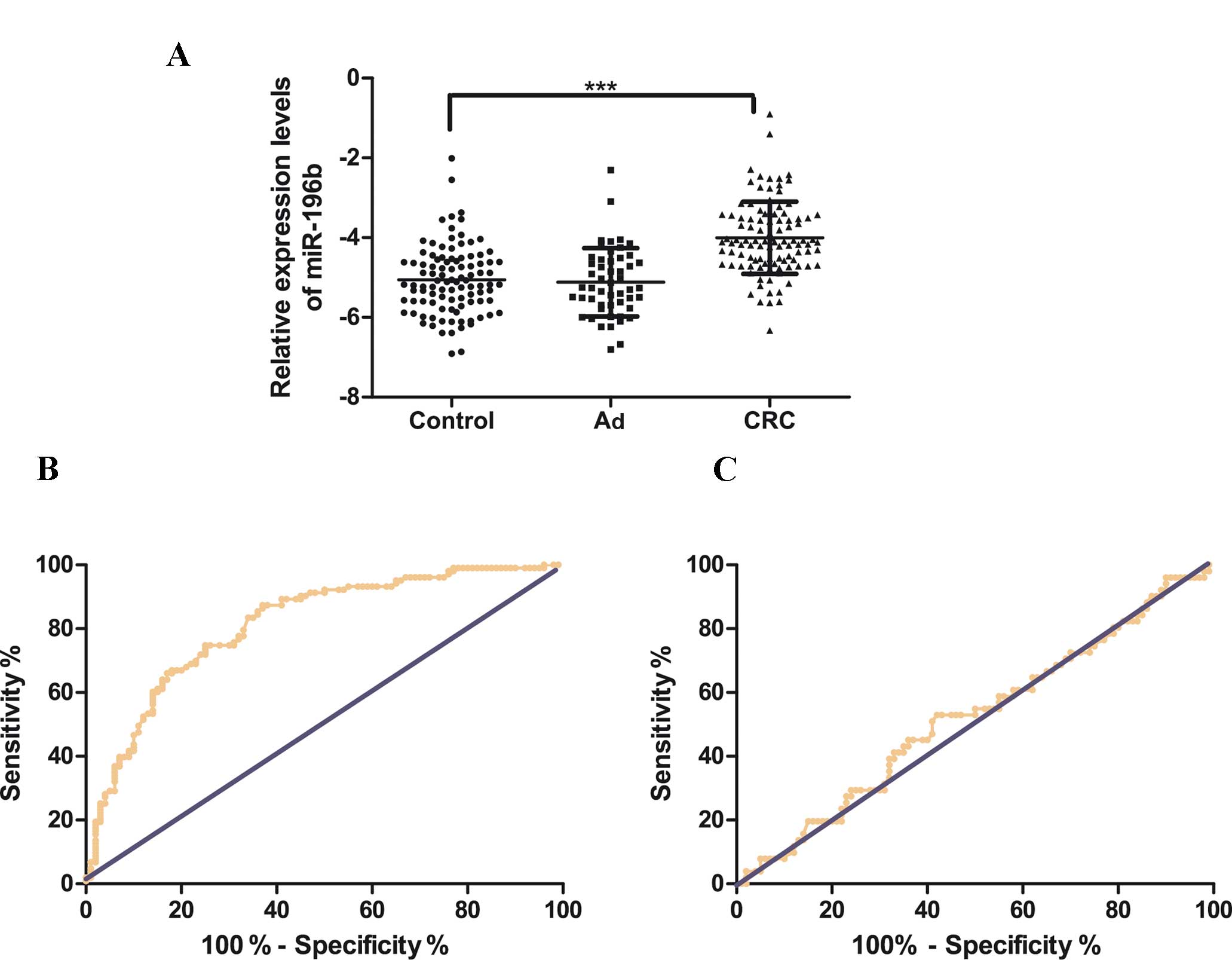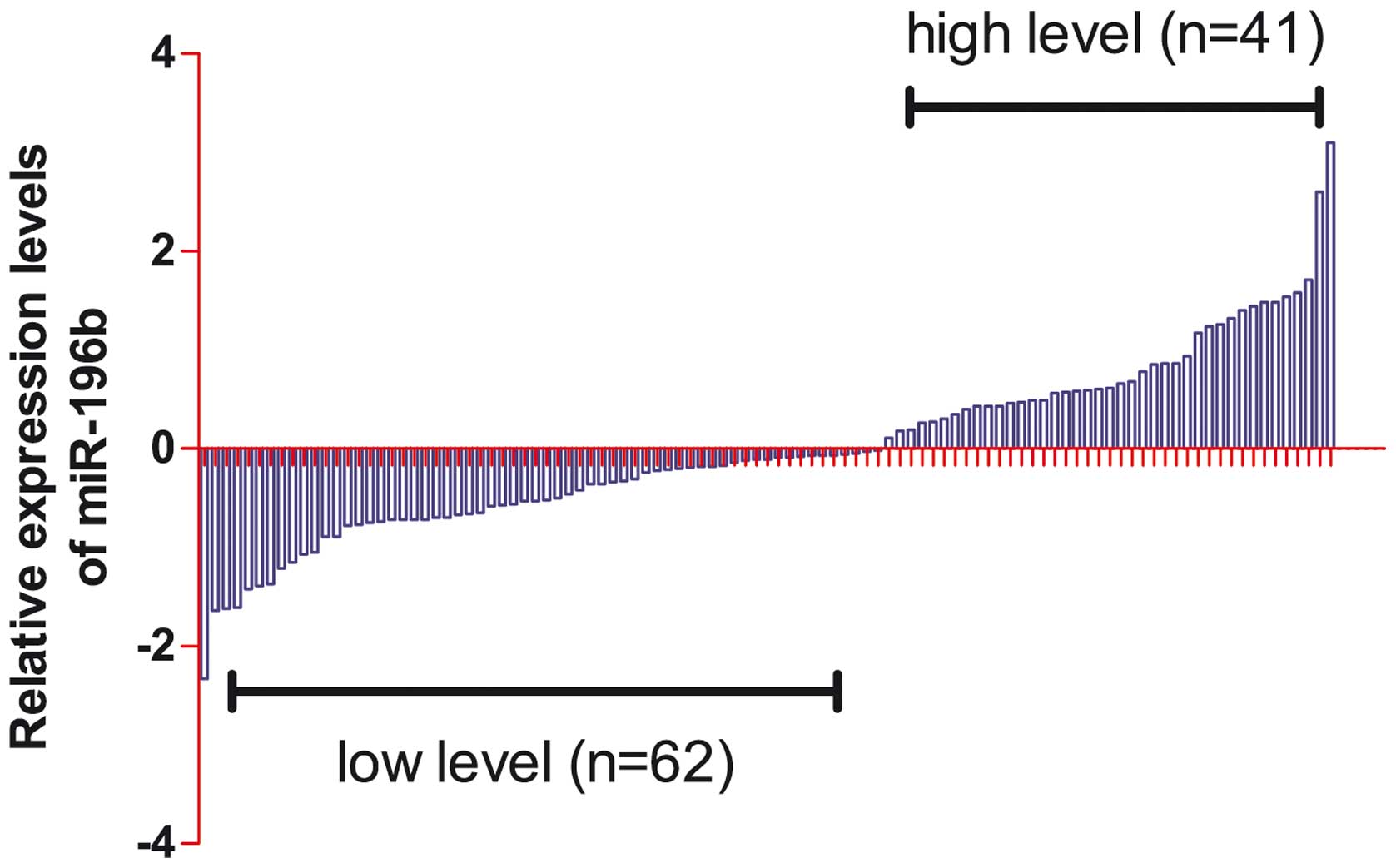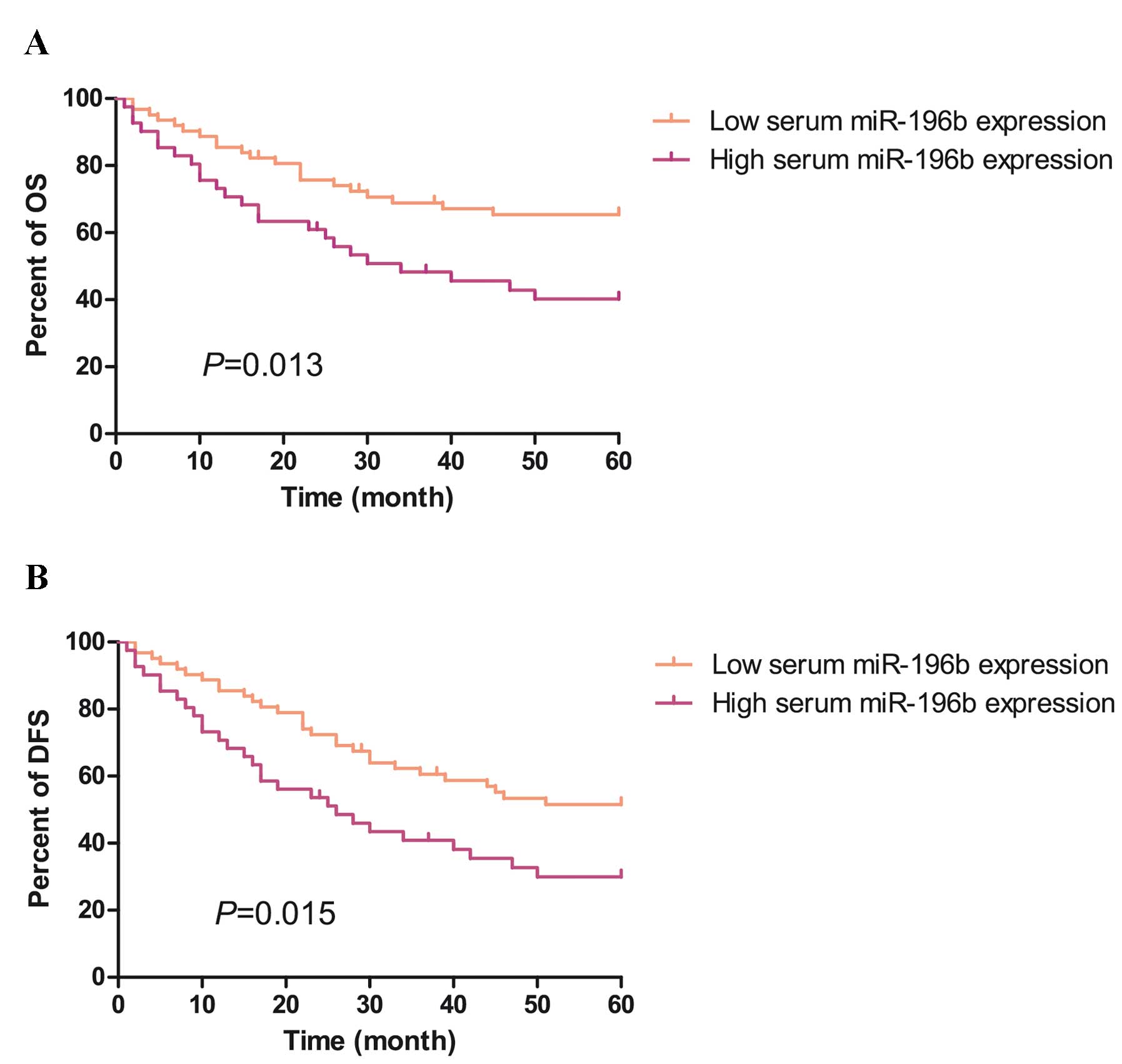|
1
|
Wei Q, Wang X, Gao J, Li J, Li J, Qi C, Li
Y, Li Z and Shen L: Clinicopathologic and molecular features of
colorectal adenocarcinoma with signet-ring cell component. PLoS
One. 11:e01566592016. View Article : Google Scholar : PubMed/NCBI
|
|
2
|
Strum WB: Colorectal Adenomas. N Engl J
Med. 374:1065–1075. 2016. View Article : Google Scholar : PubMed/NCBI
|
|
3
|
Fantini S, Salsi V, Vitobello A, Rijli FM
and Zappavigna V: MicroRNA-196b is transcribed from an autonomous
promoter and is directly regulated by Cdx2 and by posterior Hox
proteins during embryogenesis. Biochim Biophys Acta.
1849:1066–1080. 2015. View Article : Google Scholar : PubMed/NCBI
|
|
4
|
Kojima S, Goto Y and Naya Y: The roles of
microRNAs in the progression of castration-resistant prostate
cancer. J Hum Genet. Jun 9–2016.(Epub ahead of print). View Article : Google Scholar : PubMed/NCBI
|
|
5
|
Melo SA and Esteller M: Dysregulation of
microRNAs in cancer: Playing with fire. FEBS Lett. 585:2087–2099.
2011. View Article : Google Scholar : PubMed/NCBI
|
|
6
|
Zheng K, Li H, Huang H and Qiu M:
MicroRNAs and glial cell development. Neuroscientist. 18:114–118.
2012. View Article : Google Scholar : PubMed/NCBI
|
|
7
|
Lizé M, Klimke A and Dobbelstein M:
MicroRNA-449 in cell fate determination. Cell Cycle. 10:2874–2882.
2011. View Article : Google Scholar : PubMed/NCBI
|
|
8
|
Cao DD, Li L and Chan WY: MicroRNAs: Key
Regulators in the Central Nervous System and Their Implication in
Neurological Diseases. Int J Mol Sci. 17:E8422016. View Article : Google Scholar : PubMed/NCBI
|
|
9
|
Rea D, Del Vecchio V, Palma G, Barbieri A,
Falco M, Luciano A, De Biase D, Perdonà S, Facchini G and Arra C:
Mouse Models in Prostate Cancer Translational Research: From
Xenograft to PDX. Biomed Res Int. 2016:97507952016. View Article : Google Scholar : PubMed/NCBI
|
|
10
|
Landi D, Moreno V, Guino E, Vodicka P,
Pardini B, Naccarati A, Canzian F, Barale R, Gemignani F and Landi
S: Polymorphisms affecting micro-RNA regulation and associated with
the risk of dietary-related cancers: A review from the literature
and new evidence for a functional role of rs17281995 (CD86) and
rs1051690 (INSR), previously associated with colorectal cancer.
Mutat Res. 717:109–115. 2011. View Article : Google Scholar : PubMed/NCBI
|
|
11
|
Skrzypski M, Dziadziuszko R and Jassem J:
MicroRNA in lung cancer diagnostics and treatment. Mutat Res.
717:25–31. 2011. View Article : Google Scholar : PubMed/NCBI
|
|
12
|
Acunzo M and Croce CM: Downregulation of
miR-15a and miR-16-1 at 13q14 in Chronic Lymphocytic Leukemia. Clin
Chem. 62:655–656. 2016. View Article : Google Scholar : PubMed/NCBI
|
|
13
|
Huang E, Liu R and Chu Y: miRNA-15a/16: as
tumor suppressors and more. Future Oncol. 11:2351–2363. 2015.
View Article : Google Scholar : PubMed/NCBI
|
|
14
|
Wu XL, Cheng B, Li PY, Huang HJ, Zhao Q,
Dan ZL, Tian DA and Zhang P: MicroRNA-143 suppresses gastric cancer
cell growth and induces apoptosis by targeting COX-2. World J
Gastroenterol. 19:7758–7765. 2013. View Article : Google Scholar : PubMed/NCBI
|
|
15
|
Marí-Alexandre J, Sánchez-Izquierdo D,
Gilabert-Estellés J, Barceló-Molina M, Braza-Boïls A and Sandoval
J: miRNAs Regulation and Its Role as Biomarkers in Endometriosis.
Int J Mol Sci. 17:E932016. View Article : Google Scholar : PubMed/NCBI
|
|
16
|
Willeit P, Skroblin P, Kiechl S,
Fernandez-Hernando C and Mayr M: Liver microRNAs: potential
mediators and biomarkers for metabolic and cardiovascular disease?
Eur Heart J. Apr 20–2016.(Epub ahead of print). View Article : Google Scholar : PubMed/NCBI
|
|
17
|
Mansfield JH, Harfe BD, Nissen R, Obenauer
J, Srineel J, Chaudhuri A, Farzan-Kashani R, Zuker M, Pasquinelli
AE, Ruvkun G, et al: MicroRNA-responsive ‘sensor’ transgenes
uncover Hox-like and other developmentally regulated patterns of
vertebrate microRNA expression. Nat Genet. 36:1079–1083. 2004.
View Article : Google Scholar : PubMed/NCBI
|
|
18
|
Guan Y, Mizoguchi M, Yoshimoto K, Hata N,
Shono T, Suzuki SO, Araki Y, Kuga D, Nakamizo A, Amano T, et al:
MiRNA-196 is upregulated in glioblastoma but not in anaplastic
astrocytoma and has prognostic significance. Clin Cancer Res.
16:4289–4297. 2010. View Article : Google Scholar : PubMed/NCBI
|
|
19
|
Pan Y, Meng M, Zhang G, Han H and Zhou Q:
Oncogenic microRNAs in the genesis of leukemia and lymphoma. Curr
Pharm Des. 20:5260–5267. 2014. View Article : Google Scholar : PubMed/NCBI
|
|
20
|
Ge J, Chen Z, Li R, Lu T and Xiao G:
Upregulation of microRNA-196a and microRNA-196b cooperatively
correlate with aggressive progression and unfavorable prognosis in
patients with colorectal cancer. Cancer Cell Int. 14:1282014.
View Article : Google Scholar : PubMed/NCBI
|
|
21
|
Livak KJ and Schmittgen TD: Analysis of
relative gene expression data using real-time quantitative PCR and
the 2(−Delta Delta C(T)) Method. Methods. 25:402–408. 2001.
View Article : Google Scholar : PubMed/NCBI
|
|
22
|
Lee KS, Kwak Y, Nam KH, Kim DW, Kang SB,
Choe G, Kim WH and Lee HS: c-MYC Copy-Number Gain Is an Independent
Prognostic Factor in Patients with Colorectal Cancer. PLoS One.
10:e01397272015. View Article : Google Scholar : PubMed/NCBI
|
|
23
|
Wan L, Kong J, Tang J, Wu Y, Xu E, Lai M
and Zhang H: HOTAIRM1 as a potential biomarker for diagnosis of
colorectal cancer functions the role in the tumour suppressor. J
Cell Mol Med. 20:2036–2044. 2016. View Article : Google Scholar : PubMed/NCBI
|
|
24
|
Xin Y, Li Z, Shen J, Chan MT and Wu WK:
CCAT1: A pivotal oncogenic long non-coding RNA in human cancers.
Cell Prolif. 49:255–260. 2016. View Article : Google Scholar : PubMed/NCBI
|
|
25
|
Fadous-Khalifé MC, Aloulou N, Jalbout M,
Hadchity J, Aftimos G, Paris F and Hadchity E: Krüppel-like factor
4: A new potential biomarker of lung cancer. Mol Clin Oncol.
5:35–40. 2016.PubMed/NCBI
|
|
26
|
Perini MV, Montagnini AL, Coudry R,
Patzina R, Penteado S, Abdo EE, Diniz A, Jukemura J and da Cunha
JE: Prognostic significance of epidermal growth factor receptor
overexpression in pancreas cancer and nodal metastasis. ANZ J Surg.
85:174–178. 2015. View Article : Google Scholar : PubMed/NCBI
|
|
27
|
Yu H, Lindsay J, Feng ZP, Frankenberg S,
Hu Y, Carone D, Shaw G, Pask AJ, O'Neill R, Papenfuss AT, et al:
Evolution of coding and non-coding genes in HOX clusters of a
marsupial. BMC Genomics. 13:2512012. View Article : Google Scholar : PubMed/NCBI
|
|
28
|
Tellez CS, Juri DE, Do K, Picchi MA, Wang
T, Liu G, Spira A and Belinsky SA: miR-196b Is Epigenetically
Silenced during the Premalignant Stage of Lung Carcinogenesis.
Cancer Res. 76:4741–4751. 2016. View Article : Google Scholar : PubMed/NCBI
|
|
29
|
Hou YY, You JJ, Yang CM, Pan HW, Chen HC,
Lee JH, Lin YS, Liou HH, Liu PF, Chi CC, et al: Aberrant DNA
hypomethylation of miR-196b contributes to migration and invasion
of oral cancer. Oncol Lett. 11:4013–4021. 2016.PubMed/NCBI
|
|
30
|
Li CY, Liang GY, Yao WZ, Sui J, Shen X,
Zhang YQ, Peng H, Hong WW, Ye YC, Zhang ZY, et al: Identification
and functional characterization of microRNAs reveal a potential
role in gastric cancer progression. Clin Transl Oncol. May
12–2016.(Epub ahead of print).
|
|
31
|
Díaz-Beyá M, Brunet S, Nomdedéu J, Tejero
R, Díaz T, Pratcorona M, Tormo M, Ribera JM, Escoda L, Duarte R, et
al: Cooperative AML group CETLAM (Grupo Cooperativo Para el Estudio
y Tratamiento de las Leucemias Agudas y Mielodisplasias): MicroRNA
expression at diagnosis adds relevant prognostic information to
molecular categorization in patients with intermediate-risk
cytogenetic acute myeloid leukemia. Leukemia. 28:804–812. 2014.
View Article : Google Scholar : PubMed/NCBI
|
|
32
|
Liu Y, Zheng W, Song Y, Ma W and Yin H:
Low expression of miR-196b enhances the expression of BCR-ABL1 and
HOXA9 oncogenes in chronic myeloid leukemogenesis. PLoS One.
8:e684422013. View Article : Google Scholar : PubMed/NCBI
|
|
33
|
How C, Hui AB, Alajez NM, Shi W, Boutros
PC, Clarke BA, Yan R, Pintilie M, Fyles A, Hedley DW, et al:
MicroRNA-196b regulates the homeobox B7-vascular endothelial growth
factor axis in cervical cancer. PLoS One. 8:e678462013. View Article : Google Scholar : PubMed/NCBI
|
|
34
|
Li Z, Huang H, Chen P, He M, Li Y,
Arnovitz S, Jiang X, He C, Hyjek E, Zhang J, et al: miR-196b
directly targets both HOXA9/MEIS1 oncogenes and FAS tumour
suppressor in MLL-rearranged leukaemia. Nat Commun. 3:6882012.
View Article : Google Scholar : PubMed/NCBI
|
|
35
|
Ma R, Yan W, Zhang G, Lv H, Liu Z, Fang F,
Zhang W, Zhang J, Tao T, You Y, et al: Upregulation of miR-196b
confers a poor prognosis in glioblastoma patients via inducing a
proliferative phenotype. PLoS One. 7:e380962012. View Article : Google Scholar : PubMed/NCBI
|
|
36
|
Li NA, Wang W, Xu B and Gong H: miR-196b
regulates gastric cancer cell proliferation and invasion via
PI3K/AKT/mTOR signaling pathway. Oncol Lett. 11:1745–1749.
2016.PubMed/NCBI
|
|
37
|
Wang YX, Zhang XY, Zhang BF, Yang CQ, Chen
XM and Gao HJ: Initial study of microRNA expression profiles of
colonic cancer without lymph node metastasis. J Dig Dis. 11:50–54.
2010. View Article : Google Scholar : PubMed/NCBI
|












